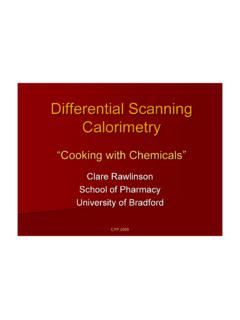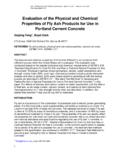Transcription of Investigating Differences in Solubility Between ...
1 Investigating Differences in Solubility Between Crystalline and amorphous Forms of PharmaceuticalsRhea BrentPharmaceutical Analytical Research and DevelopmentAstraZenecaAlderley ParkAim To determine the Differences in Solubility Between amorphous and crystalline forms of pharmaceuticals. To determine whether there are any trends Between these : Why is the Solid-state Form Important?Molecules packed in a regularly ordered, repeating pattern More stable Lower Solubility Lower riskMolecules in a random arrangement. Less stable Prone to crystallisation and degradation Higher Solubility Higher RiskThermodynamically Stable Crystalline FormAmorphous FormIdentifying the solid-state by XRPD X-ray powder diffraction is a powerful tool to determine whether a drug sample is amorphous or Diffraction PatternAmorphous Pattern: No scatter of x-raysWhy is Solubility Important?
2 Poor Solubility , poor absorption of drugs into the body, poor bioavailability. Solubility is pH dependent, so is determined at physiologically relevant pH. Increasingly more drugs with poor Solubility being made. Solubility determined early in the drug discovery process, to assess risks involved in progressing Discovery Early batches material used to assess Solubility :Limited quantity (only a few mgs)Variable purity (often low) Often amorphous / semi-crystalline (not enough bulk to assess this) Later batches produced should be the crystalline,stable form to ensure no form changes during the development period or on Solubility investigations are often performed on non-ideal materialInvestigation Drivers Study investigates effects of a change in form (from amorphous to crystalline) will have on the much of an over-estimate are early Solubility measurements?
3 Literature describes the Solubility increase from crystalline to amorphous material has been reported to be Between 10 and 1600 fold. Selected 40 structurally diverse compounds with variable solubilities. Can this comparison help us to understand how crystallisation affects Solubility ? Vol 17, , 2000 Experimental: Outline of workPerform Slurry experiments to identify form changes during experimentMeasure Solubility of amorphous FormPrepare amorphous Forms of test setMeasure Solubility of Crystalline FormCheck Crystallinity of Compounds1) By XRPD2) In pH buffer, 24 hour stirring, 25 CQuantification by LC-MS3) Making amorphous Compounds- The easy bit??Aim: Prepare amorphous forms of all 40 compoundsSolvent Approach Crash cooling, rapid addition of anti-solvent, evaporation at high temperatures. Compounds tended to recrystallise rather than stay amorphousSuccess = 1 compound!
4 Grinding / milling Mechanically disordered by grinding using a pestle and mortar and compacting. Only small amounts of amorphous in predominantly crystalline = 0 compounds!!3) Making amorphous Compounds- The easy bit??Freeze Drying Freeze a dissolved sample (acetic acid) and dry under vacuum. Hinders crystal growth. amorphous materials prepared, found to crystallise over time. Some compounds not soluble enough to = 2 compounds!Melting and rapid cooling with liquid nitrogen Melt compound in pan and rapidly cool in liquid nitrogen. Most sucessful technique, used as standard method of preparing amorphous . However, many compounds found to decompose using this = 20 compounds4) Measuring Solubility of amorphous Solubility of amorphous measured over 24h in phosphate buffer at pH Solubility measured at 10 mins, 1 and 24 hrs in excess solid.
5 Excess solid analysed by XRPD to determine Solubility taken as the maximumsolubility measured during experimentAmophous Solubility (hours) Solubility (ug/ml)ChlorpromazineResults: amorphous vs. CrystallineSolubility Changes of amorphous from Crystalline024681012decreasemoderate increasesignificant increaseNumber observed When amorphous Solubility , taken as maximum Solubility measured, amorphous solubilities found to differ from crystalline Between and 6000 foldComparing 24 hour amorphous and crystalline solubilityResults- The Crystallisation Problem amorphous solid in contact with solvent can crystallise rapidly. Solubility measured may actually be that of semi-crystalline or crystalline material? Crystallisation after 24 hours. How rapidly does crystallisation occur in solution? Is it a feature of the forced amorphous material?
6 TerfenadinePolarised Light IntensityCrystallineAmorphousPolarised Light ExperimentPolarised Light Intensity of amorphous and Crystalline Forms of Tamoxifen 050010001500 Time (mins)Light IntensityAmorphousCrystallineLooking for TrendsIn Compounds with strong crystal lattices (high melting points) will readily crystallise in solvent hence the Solubility benefit will be low. Compounds with weak crystal lattices (low melting points) are less prone to crystallise and therefore amount in solution will remain high. Greater Solubility Solubility vs. Time Appears to be a correlation of high melting point compounds with a low enhancement of Solubility and vice (Hours)Ratio of amorphous /crystallineCinnarizineChlorpro mazineBifonazolemp = 99 Cmp = 146 Cmp = 196 CConclusions Difficult to make amorphous compounds from crystalline. The tendency to degrade and/or recrystallise is very common.
7 In the majority of cases, the amorphous form of pharmaceuticals are more soluble than the crystalline form. For half of the compounds the Solubility increase remained for at least 24 hours. Physical properties melting point may indicate the enhancement of the amorphous Solubility over that of the Booth, George Kirk, Nicola Colclough, Rod Kittlety, James McCabe, Richard Storey, Mark Timms, Andrew Dobson,Jamie Scott and Trevor JohnsonQuestions?








